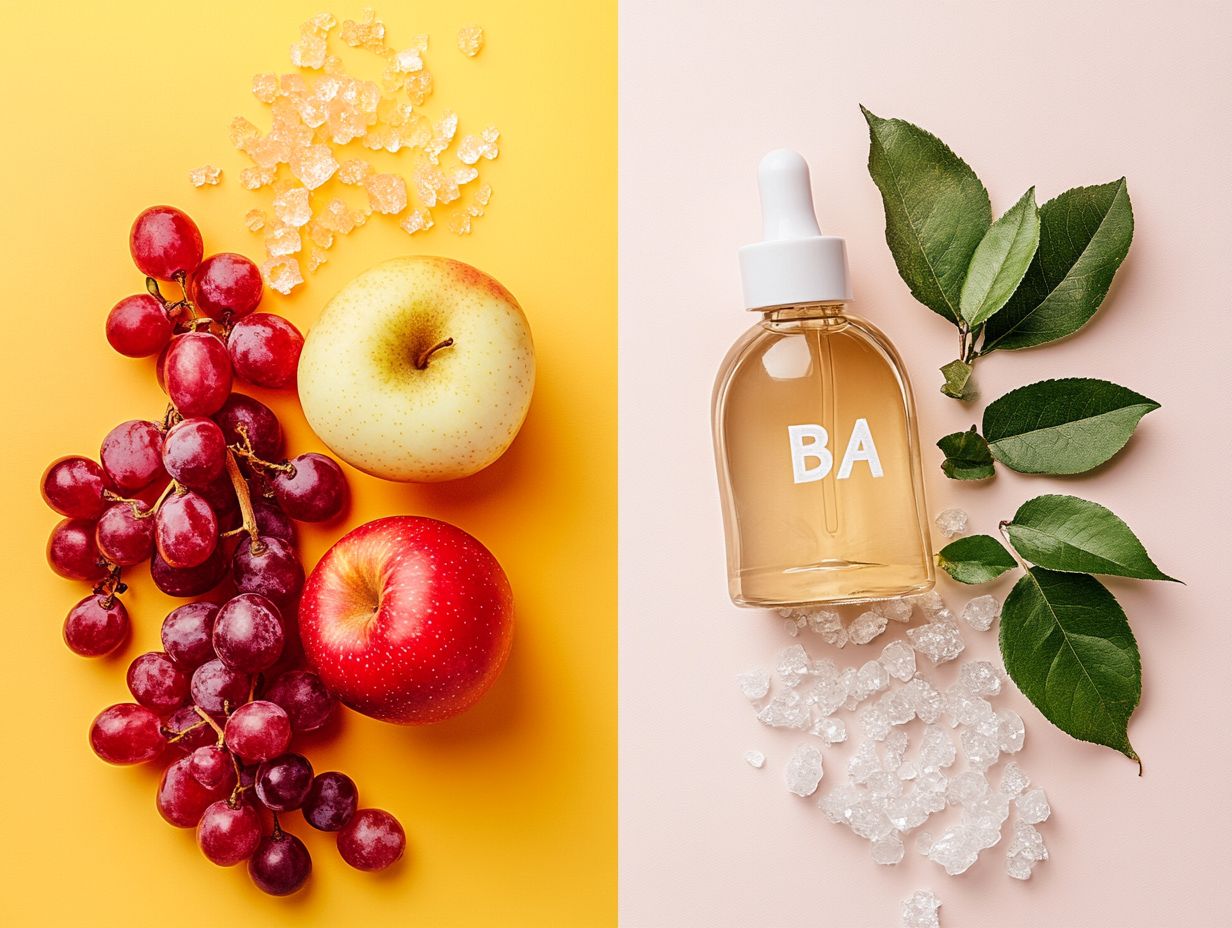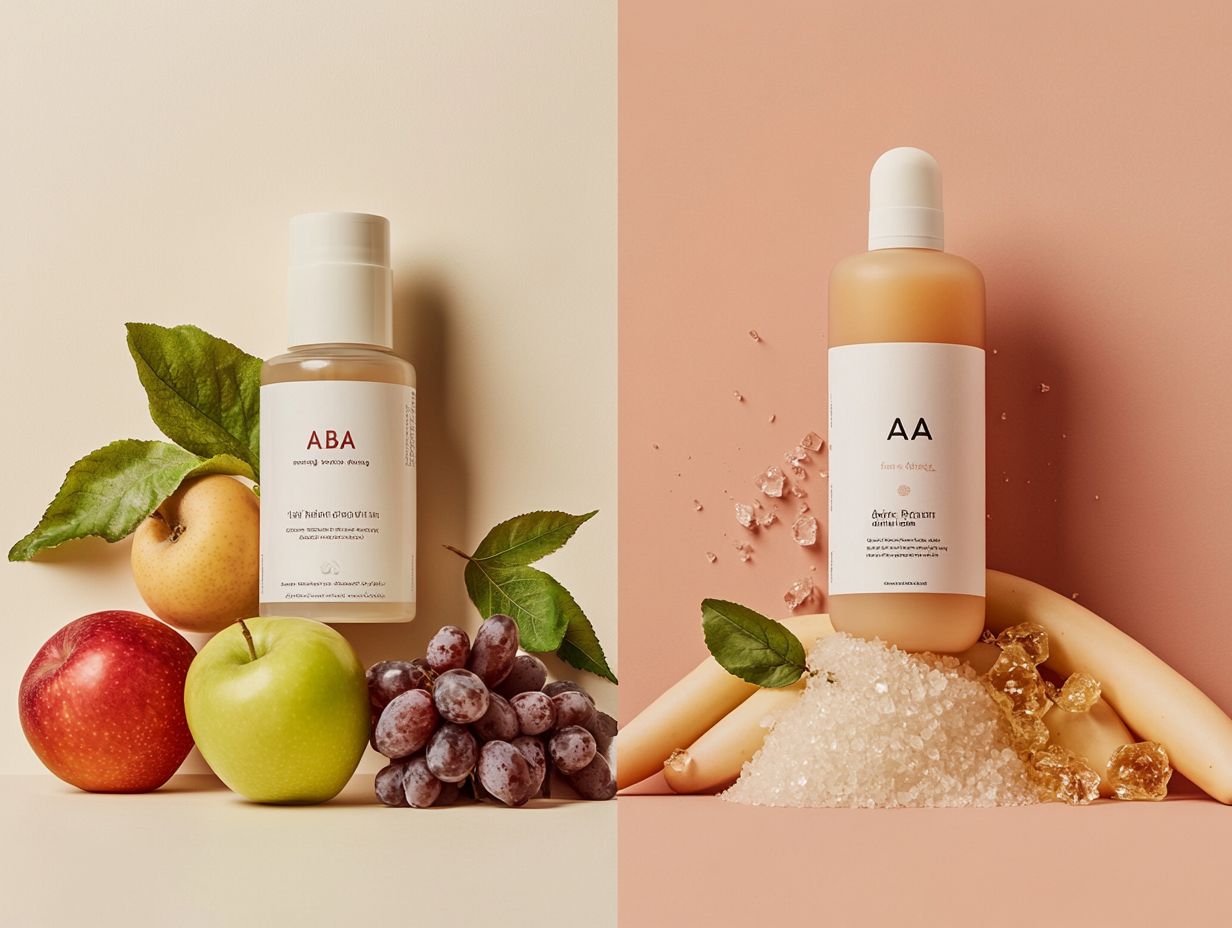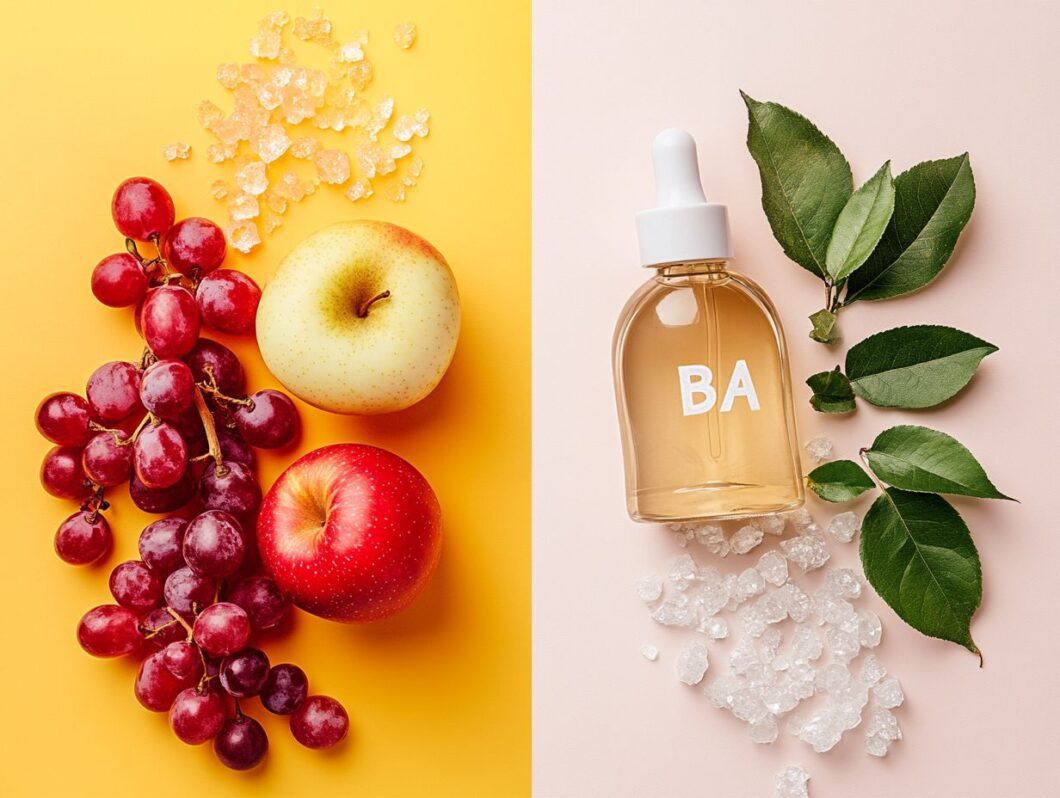Achieving radiant, healthy skin requires a clear understanding of the differences between AHAs (alpha hydroxy acids) and BHAs (beta hydroxy acids).
Both are widely recognized exfoliants, each offering distinct benefits, but knowing which one aligns best with my skin type can significantly enhance my skincare routine.
This guide will provide a detailed breakdown of their chemical compositions, explore their specific advantages, and offer tips on how to select and incorporate them safely for optimal results.
I am prepared to unlock the secrets to achieving smoother, clearer skin.
Key Takeaways:
AHAs vs. BHAs: Understanding the Difference

Alpha Hydroxy Acids (AHAs) and Beta Hydroxy Acids (BHAs) are both well-regarded chemical exfoliants that I often recommend in skincare routines. They are known for their capacity to enhance skin texture, tackle common skin concerns, and help achieve specific skin goals.
AHAs, such as glycolic acid and lactic acid, are water-soluble and work particularly well for individuals with dry or sensitive skin. In contrast, BHAs, like salicylic acid, are oil-soluble and can penetrate deeper into the pores, making them an excellent choice for those with oily or acne-prone skin. For a deeper understanding of these exfoliants, check out this article on Exploring AHAs vs. BHAs: Which Exfoliant is Right for You?
Understanding the key differences between AHAs and BHAs is essential for selecting the most appropriate exfoliant tailored to one’s skin type and addressing particular skin issues effectively.
Chemical Composition and Effects on Skin
The chemical composition of AHAs and BHAs significantly impacts their effectiveness as exfoliants. AHAs, which are derived from fruits and milk, primarily consist of glycolic acid and lactic acid. On the other hand, BHAs, such as salicylic acid, are often sourced from willow bark. For a deeper understanding, consider reading more about Exploring AHAs vs. BHAs: Which Exfoliant is Right for You?.
These distinct chemical structures dictate how each type interacts with the skin. AHAs are water-soluble, working primarily on the surface to enhance overall skin texture and provide a healthy glow. In contrast, the oil-soluble nature of BHAs enables them to penetrate deeper into the pores, effectively addressing acne and unclogging them.
Utilizing AHAs can enhance collagen production, resulting in a firmer appearance and reduced fine lines. Meanwhile, BHAs not only prevent breakouts but also help reduce inflammation, making them particularly beneficial for individuals with oily or sensitive skin.
Together, AHAs and BHAs offer a comprehensive approach to skin rejuvenation.
Benefits of AHAs

AHAs, particularly glycolic acid and lactic acid, provide a variety of benefits in skincare, primarily due to their exfoliation properties.
They effectively remove dead skin cells, enhance skin texture, and deliver remarkable anti-aging benefits by improving overall skin appearance and luminosity. These chemical exfoliants play a crucial role in diminishing fine lines, brightening uneven skin tones, and promoting a youthful glow.
As such, they have become an essential component of many beauty editors’ recommended exfoliation routines.
Exfoliation and Anti-Aging Properties
The exfoliation and anti-aging properties of AHAs are primarily linked to their capacity to stimulate collagen production and enhance skin texture, which makes them highly effective in addressing signs of aging.
As these acids exfoliate the outer layer of dead skin cells, they reveal a fresher, more youthful appearance, showcasing smoother and more radiant skin underneath. The stimulation of collagen not only diminishes the appearance of fine lines and wrinkles but also promotes elasticity, helping the skin maintain its firmness over time.
For optimal results, I typically incorporate AHAs into my skincare routine two to three times a week, adjusting frequency based on my skin’s sensitivity. It is essential to be aware of potential side effects, such as irritation or redness, particularly for those with sensitive skin.
Additionally, using sunscreen is imperative, as AHAs can increase sun sensitivity, making the skin more susceptible to UV damage.
Benefits of BHAs

I recognize the value of Beta Hydroxy Acids (BHAs), specifically salicylic acid, for their remarkable acne-fighting properties and anti-inflammatory benefits. This makes them an excellent option for individuals with oily or acne-prone skin.
Unlike Alpha Hydroxy Acids (AHAs), BHAs can penetrate deeper into the pores, effectively unclogging them and addressing a range of skin concerns such as blackheads and breakouts.
Additionally, they offer soothing effects for inflamed skin, enhancing overall skin health.
Acne-Fighting and Anti-Inflammatory Properties
The acne-fighting and anti-inflammatory properties of BHAs, particularly salicylic acid, are essential for addressing persistent skin issues such as blackheads and whiteheads. Additionally, they help calm redness and inflammation often associated with acne-prone skin.
This makes BHAs an excellent option for maintaining a healthy complexion without compromising sensitive skin. When I incorporate these acids into my daily skincare routine, they penetrate deep into the pores, promoting the gentle exfoliation of dead skin cells and excess oil.
For individuals experiencing conditions like rosacea, it’s crucial to select formulations specifically designed for sensitive skin to minimize irritation. Products such as Neutrogena’s Oil-Free Acne Wash and Paula’s Choice Skin Perfecting 2% BHA Liquid Exfoliant have received significant acclaim for their effectiveness.
I typically recommend using these serums a few times a week, gradually increasing the frequency as the skin adapts, to ensure optimal results without causing distress.
Choosing the Right Exfoliant for Your Skin Type

Selecting the appropriate exfoliant for my skin type is essential for achieving my skincare goals and effectively addressing specific concerns.
For example, I find that AHAs are generally more suitable for individuals with dry or sensitive skin, whereas BHAs are typically recommended for those with oily or acne-prone skin.
Factors to Consider
When selecting the appropriate exfoliant, I consider several important factors, including my specific skin type, any existing skin concerns, and the overall sensitivity of my skin.
Understanding whether I have oily, dry, combination, or sensitive skin is crucial, as each type responds differently to exfoliation methods. For example, I realize that individuals with sensitive skin may benefit from gentler exfoliants, while those with conditions like eczema or psoriasis must exercise particular caution to avoid irritation.
I also recognize that the frequency of exfoliation can vary; some individuals may only require it once a week, while those with oilier skin may find that more frequent sessions are beneficial. The key is to develop an exfoliation routine that respects my individual needs and promotes a healthy, balanced complexion.
How to Incorporate AHAs and BHAs into Your Skincare Routine
Incorporating AHAs and BHAs into my skincare routine can significantly enhance the health and appearance of my skin. However, it is essential to approach this process with care, considering how these chemical exfoliants interact with other products, including serums and moisturizers.
I always begin with lower concentrations and gradually build up to more potent formulations. Additionally, I recognize the critical importance of sun protection when using these powerful ingredients to maintain optimal skin health.
Tips for Safe and Effective Use
To ensure the safe and effective use of AHAs and BHAs in my skincare regimen, I begin with gentle formulations, closely monitoring my skin’s response and maintaining a healthy skin barrier.
I understand that it is essential to gradually increase the concentration of these acids, as this approach minimizes the risk of irritation or adverse reactions. By observing how my skin feels and looks after application, I gain valuable insights into its tolerance level.
Incorporating a robust hydration strategy with moisturizers is a key aspect of my routine, as it significantly helps soothe my skin and bolster its barrier function. Additionally, I recognize that sunscreen is an essential ally in my daily routine; since exfoliation can increase UV sensitivity, protecting my skin from sun damage is imperative.
Together, these measures form a proactive approach to responsible exfoliation, ensuring that my skin remains healthy and radiant.


